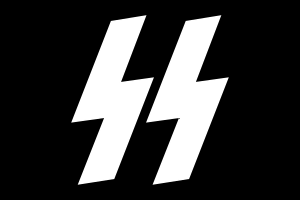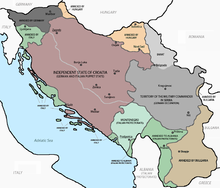
The Geheime Staatspolizei, abbreviated Gestapo, was the official secret police of Nazi Germany and in German-occupied Europe.
Sicherheitsdienst, full title Sicherheitsdienst des Reichsführers-SS, or SD, was the intelligence agency of the SS and the Nazi Party in Nazi Germany. Established in 1931, the SD was the first Nazi intelligence organization and the Gestapo was considered its sister organization through the integration of SS members and operational procedures. The SD was administered as an independent SS office between 1933 and 1939. That year, the SD was transferred over to the Reich Security Main Office, as one of its seven departments. Its first director, Reinhard Heydrich, intended for the SD to bring every single individual within the Third Reich's reach under "continuous supervision".

The Reich Security Main Office was an organization under Heinrich Himmler in his dual capacity as Chef der Deutschen Polizei and Reichsführer-SS, the head of the Nazi Party's Schutzstaffel (SS). The organization's stated duty was to fight all "enemies of the Reich" inside and outside the borders of Nazi Germany.

Bruno Streckenbach was a German SS functionary during the Nazi era. He was the head of Administration and Personnel Department of the Reich Security Main Office (RSHA). Streckenbach was responsible for many thousands of murders committed by Nazi mobile killing squads known as Einsatzgruppen.
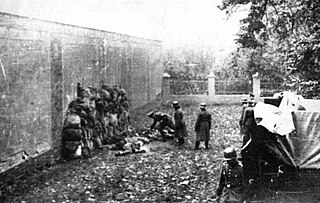
During World War II, the Nazi German Einsatzkommandos were a sub-group of the Einsatzgruppen – up to 3,000 men total – usually composed of 500–1,000 functionaries of the SS and Gestapo, whose mission was to exterminate Jews, Polish intellectuals, Romani, and communists in the captured territories often far behind the advancing German front. Einsatzkommandos, along with Sonderkommandos, were responsible for the systematic murder of Jews during the aftermath of Operation Barbarossa, the invasion of the Soviet Union. After the war, several commanders were tried in the Einsatzgruppen trial, convicted, and executed.
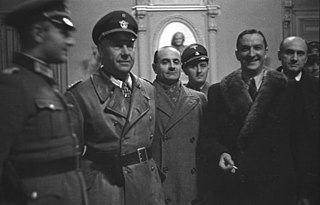
The Sicherheitspolizei, often abbreviated as SiPo, was a term used in Germany for security police. In the Nazi era, it referred to the state political and criminal investigation security agencies. It was made up by the combined forces of the Gestapo and the Kriminalpolizei between 1936 and 1939. As a formal agency, the SiPo was incorporated into the Reich Security Main Office (RSHA) in 1939, but the term continued to be used informally until the end of World War II in Europe.

Karl Rudolf Werner Best was a German jurist, police chief, SS-Obergruppenführer, Nazi Party leader, and theoretician from Darmstadt. He was the first chief of Department 1 of the Gestapo, Nazi Germany's secret police, and initiated a registry of all Jews in Germany. As a deputy of SS-Obergruppenführer Reinhard Heydrich, he organized the World War II SS-Einsatzgruppen, paramilitary death squads that carried out mass-murder in Nazi-occupied territories.

The Banjica concentration camp was a Nazi German concentration camp in the Territory of the Military Commander in Serbia, the military administration of the Third Reich established after the Invasion and occupation of Yugoslavia during World War II. In response to escalating resistance, the German army instituted severe repressive measures – mass executions of civilian hostages and the establishment of concentration camps. Located in the Banjica neighborhood of Dedinje—a suburb of Belgrade—it was originally used by the Germans as a center for holding hostages. The camp was later used to hold anti-fascist Serbs, Jews, Roma, captured Partisans, Chetniks and other opponents of Nazi Germany. By 1942, most executions occurred at the firing ranges at Jajinci, Marinkova Bara and the Jewish cemetery.

The Sajmište concentration camp was a Nazi German concentration and extermination camp during World War II. It was located at the former Belgrade fairground site near the town of Zemun, in the Independent State of Croatia (NDH). The camp was organized and operated by SS Einsatzgruppen units stationed in occupied Serbia. It became operational in September 1941 and was officially opened on 28 October of that year. The Germans dubbed it the Jewish camp in Zemun. At the end of 1941 and the beginning of 1942, thousands of Jewish women, children and old men were brought to the camp, along with 500 Jewish men and 292 Romani women and children, most of whom were from Niš, Smederevo and Šabac. Women and children were placed in makeshift barracks and suffered during numerous influenza epidemics. Kept in squalid conditions, they were provided with inadequate amounts of food and many froze to death during the winter of 1941–42. Between March and May 1942, the Germans used a gas van sent from Berlin to kill thousands of Jewish inmates.

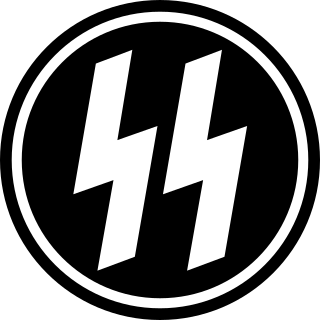
The 1st Belgrade Special Combat detachment was a special police unit which was established by the German Gestapo in the Territory of the Military Commander in Serbia during World War II.

The Serbian State Guard was a collaborationist paramilitary force used to impose law and order within the German occupied territory of Serbia during World War II. It was formed from two former Yugoslav gendarmerie regiments, was created with the approval of the German military authorities, and for a long period was controlled by the Higher SS and Police Leader in the occupied territory. It was also known as the Nedićevci after the leader of the German-installed Serbian puppet government, General Milan Nedić, who eventually gained control of its operations. It assisted the Germans in imposing one of the most brutal occupation regimes in occupied Europe and helped guard and execute prisoners at the Banjica concentration camp in Belgrade. Its leaders and much of the rank and file were sympathetic to the Chetnik movement of Draža Mihailović, and it was purged by the Germans on several occasions for that reason. In October 1944, as the Soviet Red Army closed on Belgrade, the SDS was transferred to Mihailović's control by a member of the fleeing Nedić administration, but it quickly disintegrated during its withdrawal west, with only a small number of former SDS members being captured by the British near the Italian-Yugoslav border in May 1945.
The Wannsee Conference is a 1984 German TV film portraying the events of the Wannsee Conference, held in Berlin in January 1942. The script is derived from the minutes of the meeting. Since no verbatim transcription of the meeting exists, the dialogue is necessarily fictionalised. The main theme of the film is the bureaucratic nature of the genocide.

Dragomir "Dragi" Jovanović was a Serbian politician and Axis collaborator who served as the mayor of Belgrade from 1941 to 1944, during World War II. He was captured by communist forces on December 11, 1945 in Munich in Allied occupied Germany following the war and tried alongside other Serbian collaborationist leaders in 1946. He was found guilty of collaborating with Reinhard Heydrich and Heinrich Himmler and other German officials and executed in Belgrade.
The Government of National Salvation, also referred to as Nedić's government and Nedić's regime, was the colloquial name of the second Serbian collaborationist puppet government established in the German-occupied territory of Serbia during World War II in Yugoslavia. Appointed by the German Military Commander in Serbia, it operated from 29 August 1941 to 4 October 1944. Unlike the Independent State of Croatia, the regime in occupied Serbia was never accorded status in international law and did not enjoy formal diplomatic recognition of the Axis powers.
The Commissioner Government was a short-lived Serbian collaborationist puppet government established in the German-occupied territory of Serbia within the Axis-partitioned Kingdom of Yugoslavia during World War II. It operated from 30 April to 29 August 1941, was headed by Milan Aćimović, and is also referred to as the Commissars Government or Council of Commissars. Of the ten commissioners, four had previously been ministers in various Yugoslav governments, and two had been assistant ministers. The members were pro-German, anti-semitic and anti-communist, and believed that Germany would win the war. The Aćimović government lacked any semblance of power, and was merely an instrument of the German occupation regime, carrying out its orders within the occupied territory. Under the overall control of the German Military Commander in Serbia, supervision of its day-to-day operations was the responsibility of the chief of the German administrative staff, SS-Brigadeführer and State Councillor Harald Turner. One of its early tasks was the implementation of German orders regarding the registration of Jews and Romani people living in the territory, and the placing of severe restrictions on their liberty.

During World War II, several provinces of the Kingdom of Yugoslavia corresponding to the modern-day state of Serbia were occupied by the Axis Powers from 1941 to 1944. Most of the area was occupied by the Wehrmacht and was organized as separate territory under control of the German Military Administration in Serbia. Other parts of modern Serbia that were not included in the German-administered territory were occupied and annexed by neighboring Axis countries: Syrmia was occupied and annexed by the Independent State of Croatia, Bačka was occupied and annexed by Hungary, southeastern Serbia was occupied and annexed by Bulgaria, and southwestern Serbia was occupied and annexed by Italy and included in the Italian protectorates of Albania and Montenegro.

August Edler von Meyszner was an Austrian Gendarmerie officer, right-wing politician, and senior Ordnungspolizei officer who held the post of Higher SS and Police Leader in the German-occupied territory of Serbia from January 1942 to March 1944, during World War II. He has been described as one of Reichsführer-SS Heinrich Himmler's most brutal subordinates.
The Belgrade Special Police was a Serbian collaborationist police organisation directed and controlled by the German Gestapo in the German-occupied territory of Serbia from 1941 to 1944 during World War II. It grew out of the Belgrade General Police of the interwar period, which had a significant role in the suppression of the Communist Party of Yugoslavia after that organisation was banned in 1920. Eighty per cent of work of the SP UGB related to suspected communists. It initially had a responsibility to investigate other groups, such as the Chetniks of Draža Mihailović, but ended up cooperating with Mihailović's Chetnik movement instead. The SP UGB had significant autonomy in who it arrested, tortured and interrogated, and who it sent to the Banjica concentration camp, but did not have the power to release prisoners from the camp, a power which was retained by the Gestapo. The SP UGB exchanged information with a number of different agencies, including the German military intelligence service, the Abwehr, and other collaborationist organisations such as the Serbian Volunteer Corps.
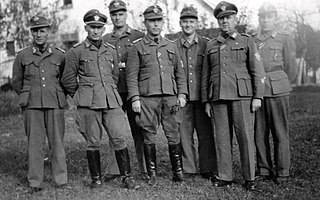
The German-Croatian Police, also known as the German-Croatian SS Police and Gendarmerie, was a force established by the SS for internal security operations in the Independent State of Croatia. In all, 32,000 Croats served in the various units of this Police force, under German command, with the task of preserving order and help defend Axis strategic positions throughout the country.
